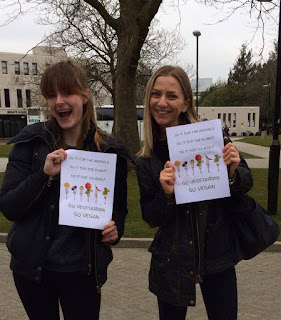The aim of our project was to decrease the amount of meat eaten on campus and increase awareness among students about the health and environmental benefits of doing so. Using various mediums such as displaying posters, sharing information on social media platforms, and through persuasion and influence techniques; we conducted a week-long awareness and influence campaign.We created an infographic (Picture 1) and posted it across social media platforms: Facebook, Twitter and Instagram (Picture 2). We also used a consistent logo and message across all mediums (Picture 3). Moreover, we split into pairs and stood at the Bread Oven counter and Library Café respectively for 20 minutes a day for 5 days (Monday-Friday), handing out slips of paper (Picture 4) to people who had chosen a meat free meal. On social media pages, we shared informative pictures and videos to convey the information and provoke shock. Additionally, recipes and suggested alternatives to meat were also posted and shared in order to facilitate and help followers change their diets. Furthermore, using social media platforms allowed us to measure responsiveness through the number of likes and hits on our Facebook page, Twitter page and followers on Instagram.Picture 1: Infographic  Picture 2: Snapshots of posts on social media
Picture 2: Snapshots of posts on social media Picture 3: Logo
Picture 3: Logo Picture 4: Congratulating Slip
Picture 4: Congratulating Slip Rebecca Claudia ZijderveldMartha RichardsEmma Orton Lillian Chan
Rebecca Claudia ZijderveldMartha RichardsEmma Orton Lillian Chan
Shrink your stress, stretch your grades
My project involved students writing down a grateful thought everyday for a week, with my target being to reduce their stress and thus allow for better exam performance. Studies show that excessive stress, which has a negative correlation with student performance, can be ameliorated via positive thinking. Thus, fliers with 7 daily slots for writing grateful thoughts and rating stress level were not only distributed but also placed on tables in the Student Union atrium, the library, Tocil hall and PAIS common room to attract students.
Thus, fliers with 7 daily slots for writing grateful thoughts and rating stress level were not only distributed but also placed on tables in the Student Union atrium, the library, Tocil hall and PAIS common room to attract students. The rationale for putting the fliers around campus was the availability heuristic; the more people saw the flier, the more likely they were to pick it up (Pratkanis, Pratkanis & Aronson, 2001).
The rationale for putting the fliers around campus was the availability heuristic; the more people saw the flier, the more likely they were to pick it up (Pratkanis, Pratkanis & Aronson, 2001). The goal was for individuals to deposit anonymous feedback on their stress and positivity level at the end of the week in a drop box so I could measure the efficacy of the intervention. Hence, the flier had a statement saying “by returning this section, you agree to the use of your anonymous feedback for research purposes”, to account for informed consent. However, I did not get substantial responses to allow for proper deduction. Nonetheless, I believe this project aided positivity and stress relief in students. Future interventions can use a more comprehensive method of participant recruitment and follow-up to gather necessary data for true empirical support.ReferencesEmmons, R. A., & McCullough, M. E. (2003). Counting blessings versus burdens: an experimental investigation of gratitude and subjective well-being in daily life. Journal of personality and social psychology, 84(2), 377. Pratkanis, A. R., Pratkanis, A., & Aronson, E. (2001). Age of propaganda: The everyday use and abuse of persuasion. Macmillan.Vanessa Ajagu
The goal was for individuals to deposit anonymous feedback on their stress and positivity level at the end of the week in a drop box so I could measure the efficacy of the intervention. Hence, the flier had a statement saying “by returning this section, you agree to the use of your anonymous feedback for research purposes”, to account for informed consent. However, I did not get substantial responses to allow for proper deduction. Nonetheless, I believe this project aided positivity and stress relief in students. Future interventions can use a more comprehensive method of participant recruitment and follow-up to gather necessary data for true empirical support.ReferencesEmmons, R. A., & McCullough, M. E. (2003). Counting blessings versus burdens: an experimental investigation of gratitude and subjective well-being in daily life. Journal of personality and social psychology, 84(2), 377. Pratkanis, A. R., Pratkanis, A., & Aronson, E. (2001). Age of propaganda: The everyday use and abuse of persuasion. Macmillan.Vanessa Ajagu
‘Go Vegetarian, Go Vegan’ Campaign
For our project, we wanted to see if our posters could influence whether people would favour vegetarian options in Xananas. We designed a poster which promoted the choice of vegetarianism and veganism. We wanted to see if the mere exposure of the posters, could influence the choice of meal they have at xananas.  The mere exposure effect (also known as the familiarity principle) suggests that people favour stimuli they have been repeatedly exposed to compared to unfamiliar stimuli (Zajonc, 1968).
The mere exposure effect (also known as the familiarity principle) suggests that people favour stimuli they have been repeatedly exposed to compared to unfamiliar stimuli (Zajonc, 1968).  By sticking up our posters around campus, we hope that the mere exposure and familiarity of ‘the vegetarian option’ will aid people to pick vegetarian menu items in Xananas. To see if our posters had any effect, we compared the average of term 2 meal sales to one day where we exposed our posters. We wanted to see if the sales of vegetarian meals increased.
By sticking up our posters around campus, we hope that the mere exposure and familiarity of ‘the vegetarian option’ will aid people to pick vegetarian menu items in Xananas. To see if our posters had any effect, we compared the average of term 2 meal sales to one day where we exposed our posters. We wanted to see if the sales of vegetarian meals increased.  Our results can be seen in the table. For breakfast and main meals there is an increase in vegetarian sales. However, starters and sandwiches did not increase with the exposure of our posters.
Our results can be seen in the table. For breakfast and main meals there is an increase in vegetarian sales. However, starters and sandwiches did not increase with the exposure of our posters. To some extent, we can suggest that the exposure effect has been seen and has influenced peoples’ choices in their meals. Jessi Silvester, Laura Schmidt, Hannah Stewart & Robyn CufleyReferences Zajonc, R. B. (1968). Attitudinal effects of mere exposure. Journal of personality and social psychology, 9, 1.
To some extent, we can suggest that the exposure effect has been seen and has influenced peoples’ choices in their meals. Jessi Silvester, Laura Schmidt, Hannah Stewart & Robyn CufleyReferences Zajonc, R. B. (1968). Attitudinal effects of mere exposure. Journal of personality and social psychology, 9, 1.
- « Previous Page
- 1
- …
- 12
- 13
- 14
- 15
- 16
- …
- 88
- Next Page »